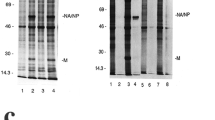Abstract
Several B 10 strains of mice, recombinant at theH-2 locus, have been shown to differ in their resistance to infection with ectromelia virus, a natural mouse pathogen. Of 10 strains, 1310, B 10.A(2R), B10.A(4R) and B10.D2 were the most resistant, while B10.G and B 10.A(5R) were the most susceptible. Other strains were intermediate between these extremes. Several genes conferring resistance have been mapped toD b in B10.A(2R),K k I-A k I-B k in B10.A,I-J b in B10.A(2R) and toD d in B 10.T(6R). In general, death among susceptible strains was not a consequence of acute liver necrosis as in other non-B10 strains, and occurred randomly from 8–14 days after infection. The exact cause of death is unknown but is characterized by persisting high titers of virus in the spleen and sometimes the liver, despite an ongoing immune response indicated by strong cytotoxic T-cell activity detectable in the spleens of all mice. The most resistant B10 and B10.A(2R) strains cleared virus from the spleen and liver by 8 days after infection. Analysis of infection in chimeric mice indicates thatH-2 genes, which determine susceptibility to virus persistence in the spleen, operate via radiosensitive cells of the lymphomyeloid system. This evidence, together with several examples ofH-2-linked differences in cytotoxic T-cell responsiveness between resistant and susceptible strains, is consistent with the hypothesis that the mechanism by whichH-2 genes control resistance to ectromelia virus in B10 strain mice is by their influence on the effectiveness of a cell-mediated immune response.
Similar content being viewed by others
References
Blanden, R. V.: Mechanisms of recovery from a generalized viral infection: mousepox. I. The effects of anti-thymocyte serum.J. Exp. Med. 132: 1035–1054, 1970
Blanden, R. V.: Mechanisms of recovery from a generalized viral infection. II. Passive transfer of recovery mechanisms with immune lymphoid cells.J. Exp. Med. 133: 1074–1089, 1971a
Blanden, R. V.: Mechanisms of recovery from a generalized viral infection: mousepox. III. Regression of infectious foci.J. Exp. Med. 133: 1090–1104, 1971b
Blanden, R. V. and Andrew, M. E.: Primary anti-viral cytotoxic T-cell responses in semiallogeneic chimeras are not absolutely restricted to host H-2 type.J. Exp. Med. 149: 535–538, 1979
Blanden, R. V. and Gardner, I. D.: The cell-mediated immune response to ectromelia virus infection. I. Kinetics and characteristics of the primary effector T cell response in vivo.Cell Immunol. 22: 271–282, 1976
Blanden, R. V., Doherty, P. C., Dunlop, M. B. C., Gardner, L. D., Zinkernagel, R. M., and David, C. S.: Genes required for cytotoxicity against virus-infected target cells inK andD regions of the H-2 complex.Nature 254: 269–270, 1975
Briody, B. A.: Response of mice to ectromelia and vaccinia viruses.Bacteriol. Rev. 23: 61–95, 1959
Chalmer, J. E., McKenzie, J. S., and Stanley, N. F.: Resistance to murine cytomegalovirus linked to the major histocompatibility complex of the mouse.J. Gen. Virol. 37: 107–114, 1977
Doherty, P. C., Blanden, R. V., and Zinkernagel, R. M.: Specificity of virus-immune effector T cells for H2K or H-2D compatible interactions: Implications for H-antigen diversity.Transplant. Rev. 29: 89–124, 1976
Doherty, P. C., Biddison, W. E., Bennink, J. R., and Knowles, B. B.: Cytotoxic T-cell responses in mice infected with influenza and vaccinia viruses vary in magnitude withH-2 genotype.J. Exp. Med. 148: 534–543, 1978
Fenner, F.: Mousepox (infectious ectromelia of mice): a review.J. Immunol. 63: 341–373, 1949a
Fenner,F.: The clinical features and pathogenesis of mouse-pox (infectious ectromelia of mice).J. Pathol Bacteriol. 60: 529–552, 1949b
Gardner, I. D. and Blanden, R. V.: The cell-mediated immune response to ectromelia virus infection. II. Secondary responsein vitro and kinetics of memory T cell productionin vivo.Cell Immunol. 22: 283–296, 1976
Gardner, I. D., Bowern, N. A., and Blanden, R. V.: Cell-mediated cytotoxicity against ectromelia virusinfected target cells. II. Identification of effector cells and analysis of mechanisms.Eur. J. Immunol. 4: 68–72, 1974
Grundy, J. E., McKenzie, J. S., and Stanley, N. F.: Influence ofH-2 and non-H-2 genes on resistance to murine cytomegalovirus infection.Infect. Immun. 32: 277–286, 1981
Kees, U. R. and Blanden, R. V.: A single genetic element in H-2K affects mouse T-cell antiviral function in pox virus infection.J. Exp. Med. 143: 450–455, 1976
Lilly, F. and Pincus, T.: Genetic control of murine viral leukemogenesis.Adv. Cancer Res. 17: 231–277, 1973
Meruelo, D.: A role for elevated H-2 antigen expression in resistance to neoplasia caused by radiationinduced leukemia virus. Enhancement of effective tumour surveillance by killer lymphocytes.J. Exp. Med. 149: 898–909, 1979
O'Neill, H. C. and Blanden, R. V.: Quantitative differences in the expression of parentally-derived H-2 antigens in F1 hybrid mice affect T-cell responses.J. Exp. Med. 149: 724–731, 1979
O'Neill, H. C. and Blanden, R. V.: Mechanisms determining innate resistance to ectromelia virus in C57BL mice.Infect. Immun., in press, 1983
Reed, K. J. and Meunch, H.: A simple method of estimating fifty per cent end points.Am. J. Hyg. 27: 493–499, 1938
Roberts, J. A.: Growth of virulent and attenuated ectromelia virus in cultured macrophage from normal and ectromelia immune mice.J. Immunol. 92: 837–842, 1964
Schell, K.: Studies on the innate resistance of mice to infection with mousepox. I. Resistance and antibody production.Aust. J. Exp. Biol. 38: 271–288, 1960
Zinkernagel, R. M., Althage, A., Cooper, S., Kreele, G., Klein, P. A., Sefton, B., Flaherty, L., Stimpfling, J., Shreffler, D., and Klein, J.: Ir genes inH-2 regulate generation of anti-viral cytotoxic T cells. Mapping to K or D and dominance of unresponsiveness.J. Exp. Med. 148: 592–606, 1978a
Zinkernagel, R. M., Callahan, G. A., Althage, A., Cooper, S., Streinlein, J. W., and Klein, J.: The lymphoreticular system in triggering virus-plus-self cytotoxic T cells. Evidence for T help.J. Exp. Med. 147: 897–911, 1978b
Author information
Authors and Affiliations
Rights and permissions
About this article
Cite this article
O'Neill, H.C., Blandenr, R.V. & O'Neill, T.J. H-2-linked control of resistance to Ectromelia virus infection in 1310 congenic mice. Immunogenetics 18, 255–265 (1983). https://doi.org/10.1007/BF00952964
Received:
Revised:
Issue Date:
DOI: https://doi.org/10.1007/BF00952964




